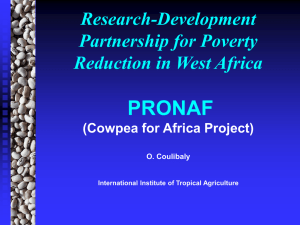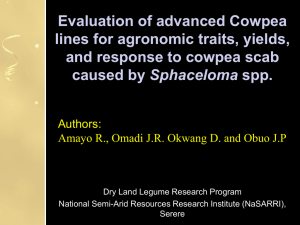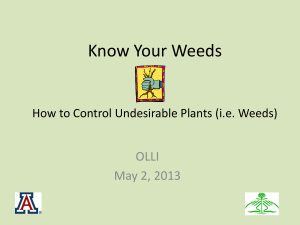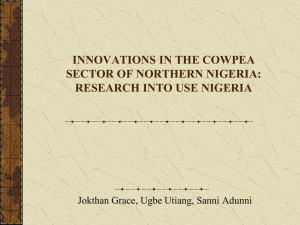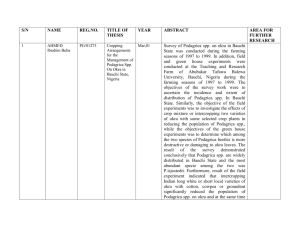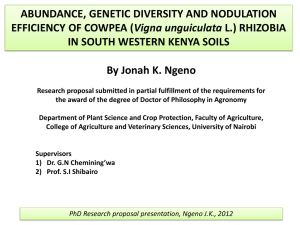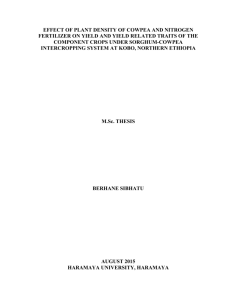EFFECTS OF PICKING COWPEA LEAVES ON WEED CONTROL
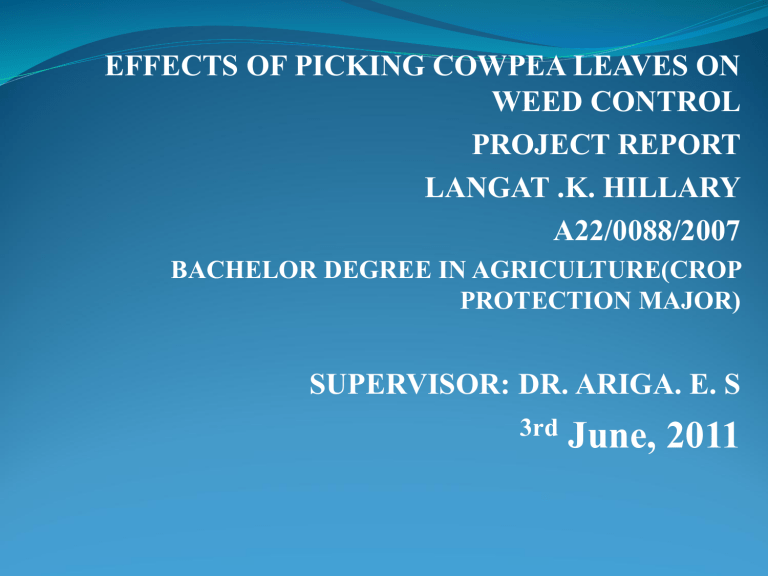
EFFECTS OF PICKING COWPEA LEAVES ON
WEED CONTROL
PROJECT REPORT
LANGAT .K. HILLARY
A22/0088/2007
BACHELOR DEGREE IN AGRICULTURE(CROP
PROTECTION MAJOR)
SUPERVISOR: DR. ARIGA. E. S
3rd June, 2011
INTRODUCTION
Cowpea( Vigna unguiculata(L ) an annual legume which originated in Africa.
It is chiefly used as a grain crop, for animal fodder, or as a vegetable.
yield potential is about 1.5-3tones per hacter
EFFECTS OF WEEDS
• Compete for light, nutrients, water, harbor insects& intercepting chemicals.
• Results in 40-81% of grain yields.
WEED SUPPRESSION BY COWPEA
Bushy and spreading varieties are known to suppress weeds
reduce yield loss due to weeds from 40-81% up to 30-65%
.
suppress weeds by reducing light penetration and by providing unconducive environmental conditions
(microclimate).
PROBLEM STATEMENT
Farmers prefer dual variety of cowpea that they can used as vegetable and harvest seeds at end of season. When excess leaves of cowpea are harvested (reducing canopy) it is possible that the effectiveness of cowpea on weeds suppression and Grain yield is reduced and it results in
Protein malnutrition among children under the age of 5years in places commonly grown as an important source of protein.
JUSTIFICATION
Many farmers prefer the use of dual cowpea in that they can use leaves as vegetables and harvest seeds, most of them tend to harvest the leaves in excess leading to reduced yield and reduced weed suppression which causes malnutrition on children below 5years in areas grown as source of protein.
These problems calls determination of the maximum number of leaves that can harvested from a dual cowpea so as to prevent yield loss on seeds and to also prevent an increase in weed attack which may result in yield loss.
OBJECTIVES
Broad objective
Was to determine the effect frequency of picking leaves of dual cowpea on weed suppression ability and grain yield
(variety k-80)
Specific objectives
Was to determine the effect of frequency of leaf picking on weed suppression ability of dual cowpea.
Was to establish the effect of frequency of leaf picking on grain yield of dual cowpea.
HYPOTHESIS
There is an increased weed growth and development
(increased weed attack) when the cowpea leaves are picked depending on frequency of leaf picking.
There is a reduction in cowpea yield when the leaves are picked subject to frequency of leaf picking.
MATERIALS AND METHODS
EXPERIMENTAL SITE
The experiment was carried out at the faculty of
Agriculture Farm, Kabete campus from the month of
February to May.
Its on an altitude of 1’15S and of longitude36’44E.
The soils are reddish brown nitisol.
Soil P.H of4.5-7.0
cation exchange capacity of 16me/100g.
.The mean annual rainfall is approximately 964.3mm.
MATERIALS USED
32 plots each measuring 3mx3m
About 1 kg of sowing seeds
Water(rain or irrigation water)
Cultivation tools
Source of labor
Two 90kg of organic manure
Pesticides
Fungicides
TREATMENTS
All treatments replicated 4times
No weeding and leaf picking done 30DAP
No weeding and leaf picking done 30& 45DAP
No weeding and leaf picking done 30, 45& 60DAP
Weeding and leaf picking done 30DAP
Weeding and leaf picking done 30& 45DAP
Weeding and leaf picking done 30, 45& 60DAP
No weeding and No leaf picking done
Weeding and No leaf picking done
RESULTS AND ANALYSIS
CUMULATIVE YIELD FOR COWPEA LEAVES IN GMS/PLOT
600
YIELD (g) 300
200
100
500
400
0
TREATMENTS
2
5
1
4
3
6
DISCUSION
Comparison of treatment
T1 & T4 both harvesting of leaves done after 30DAP shows slight diff on yield due to fact that weeds are starting to establish themselves and are starting to compete for nutrients and water.
T2& 2and 5 in which harvesting done 30 and 45DAP shows, significant diff in c.yield since weeds established well enough to compete for nutrients and water with the crops. Harvesting of leaves led to a reduction on crop canopy which reduces its ability to suppress weeds leading to increased weed attack. There was also reduction in photosynthesis due to harvesting of leaves. These led to a reduction in yield.
cont’
T3 % 5 in which harvesting was done 30,45% 60DAP v. significant diffi c. yields since weeds have fully established and increased significantly in numbers resulting in reduction of yields
increased weed attack can also be attributed to fact that weed suppression of cowpea was greatly compromised by increased frequency of harvesting leaves.
60
50
40
30
20
10
0
70
Cumulative weeds per treatment
TREATMENTS
2
5
1
4
3
6
DISCUSION
Comparison between treatments
T1 had slightly more c.weeds thanT4 since harvesting was done 30DAP. Increase in weed POP’is due to reduction in crop canopy i.e. increased light penetration was favors the growth of weeds.
There was a significant difference in c.weed pop’in T2 and 5 due to increased frequency of harvesting leaves at an interval of 30& 45 dap results in reduction of crop canopy which allows increased light penetration which favors the growth and development of weeds.
cont’
Big diff’ on c. weeds onT3 and 5 can be attributed to the increased frequency of harvesting leaves at an interval of
30,45 & 60 DAP which greatly reduces crop canopy which reduces the ability of cowpea to suppress weeds.
T3 had v.high number of weeds as compared to T6.
Increased frequency of harvesting leaves reduces the ability of cowpea to suppress weeds i.e. results in more light penetration which favors the growth of weeds.
CONLUSION
Increased in frequency of harvesting cowpea leaves reduces the ability of cowpea to suppress weeds
A c.yield of cowpea reduces with increase in frequency of harvesting leaves due to reduction in the photosynthetic materials.
This principle has been reported by Anderson (1996)
RECOMENDATION
Farmers in Kenya advised not to harvest leaves in excess so as to obtain max grain yields.


